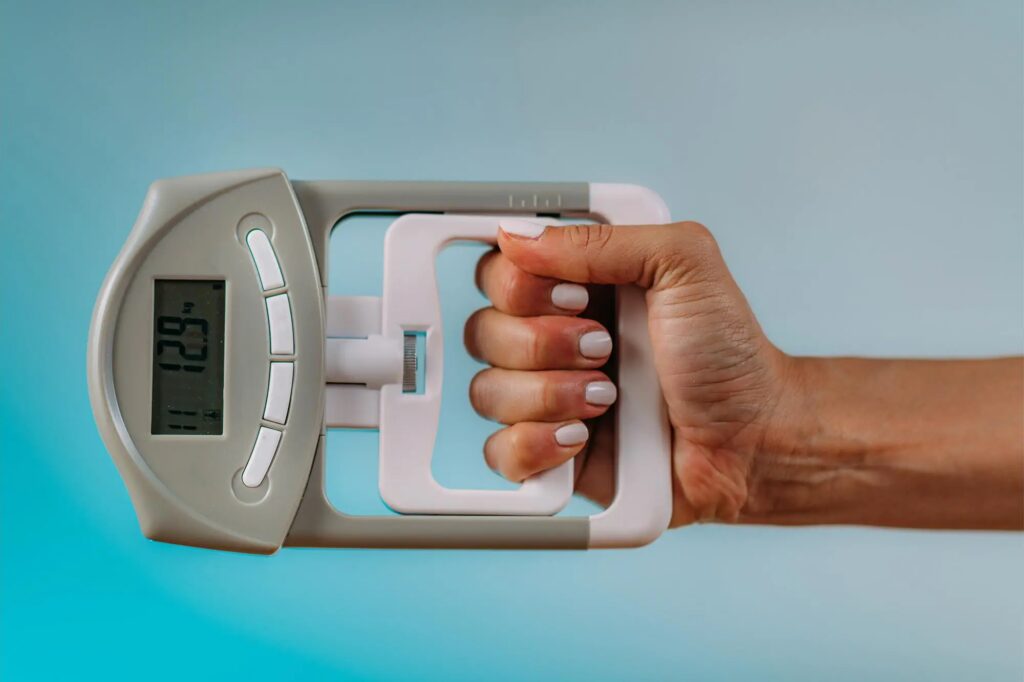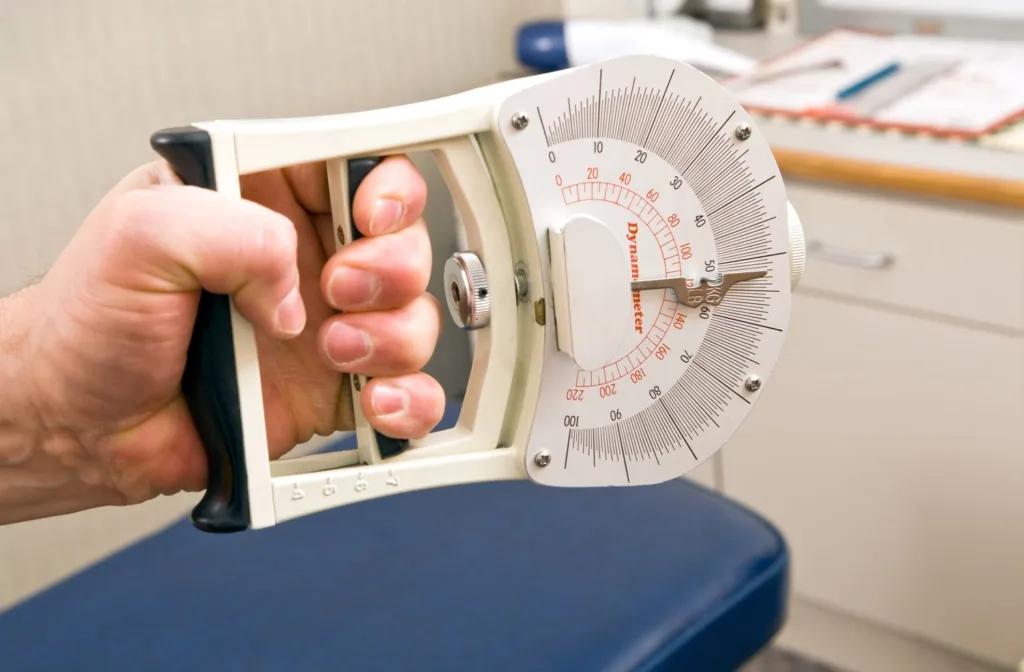Handgrip is a simple maneuver that can be performed during a physical examination to assess various cardiac conditions. It involves asking the patient to grip an object, such as a sphygmomanometer, with their hand. The act of handgrip increases the afterload, which is the resistance that the heart must overcome to eject blood into the systemic circulation.
Hand grip increases afterload by increasing the systemic vascular resistance. This occurs beause the act of gripping a hand-held object causes an increase in sympathetic nervous system activity, which in turn causes vasoconstriction of the blood vessels. This vasoconstriction leads to an increase in the resistance that the heart must overcome to eject blood into the circulation, thereby increasing the afterload.
The effect of handgrip on cardiac murmurs varies depending on the underlying pathology. In general, handgrip will increase the intensity of murmurs due to aortic regurgitation, mitral regurgitation, and ventricular septal defect. This is because the increased afterload caused by handgrip leads to an increase in the volume of blood that regurgitates through these valves or defects.
On the other hand, handgrip will decrease the intensity of murmurs due to hypertrophic obstructive cardiomyopathy and mitral valve prolapse. This is because the increased afterload caused by handgrip leads to a decrease in the left ventricular emptying, which results in a relative increase in left ventricular volume during systole. This decrease in left ventricular emptying diminishes the intensity of the murmur.
Handgrip is most useful in differentiating the ejection systolic murmur of aortic stenosis from the murmur of mitral regurgitation. The intensity of the murmur of aortic stenosis tends to decrease, while the murmur of mitral regurgitation increases when handgrip is sustained for 20 to 30 seconds. This is because the increased afterload caused by handgrip decreases the volume of blood that is ejected through the stenotic aortic valve, while increasing the volume of blood that regurgitates through the mitral valve.
Handgrip is a simple maneuver that can be used to assess various cardiac conditions. It increases afterload by increasing the systemic vascular resistance and can be used to differentiate between various cardiac murmurs. However, it is important to note that handgrip should not be used in isolation to diagnose or manage cardiac conditions and should be used in conjunction with other clinical findings and diagnostic tests.
The Effects of Handgrip on Preload and Afterload
Handgrip increases afterload, not preload. Afterload refers to the resistance the heart must overcome to eject blood into the systemic circulation. When you grip an object tightly, you increase the systemic vascular resistance, which in turn increases the afterload for the heart. This results in an increase in the intensity of murmurs due to aortic regurgitation, mitral regurgitation, and ventricular septal defect.
On the other hand, preload refers to the amount of blood that fills the heart bfore it contracts. Handgrip does not affect preload.
It’s important to note that handgrip is one of the many maneuvers used during a cardiac exam to assess murmurs and heart function. Other maneuvers include squatting, which increases preload, and standing up, which decreases preload. These maneuvers help to identify different types of murmurs and evaluate heart function.
Handgrip increases afterload and has no effect on preload. It is a useful maneuver in the assessment of certain types of murmurs and heart function during a cardiac exam.

Effect of Handgrip on Afterload
Handgrip, also known as the Valsalva maneuver, is a technique used in the medical field to increase afterload. Afterload refers to the amount of resistance that the heart must overcome to pump blood out of the left ventricle and into the aorta. By increasing afterload, handgrip can have several effects on the cardiovascular system.
Firstly, handgrip can increase left ventricular afterload. This means that the heart has to work harder to pump blood out of the left ventricle and into the aorta. The increased resistance in the aorta can cause an increase in blood pressure, which can have both positive and negative effects on the body.
Secondly, handgrip can decrease left ventricular emptying. This means that the heart is not able to pump as much blood out of the left ventricle with each beat. This can lead to an increase in left ventricular volume duing systole, which can have a negative effect on heart function.
The effect of handgrip on afterload can be complex and depend on a variety of factors, including the individual’s overall cardiovascular health and the specific medical conditions they may have. However, it is clear that handgrip can have a significant impact on the cardiovascular system and should be used with caution in individuals with certain medical conditions.
The Effects of the Handgrip Maneuver
Handgrip maneuver is a simple yet effective technique used in clinical examination to differentiate between the murmurs of aortic stenosis and mitral regurgitation. It involves asking the patient to squeeze a handgrip device for 20 to 30 seconds while the physician listens to the heart sounds. The maneuver increases systemic vascular resistance, leading to an increase in afterload and left ventricular pressure.
In patients with aortic stenosis, the handgrip maneuver causes a reduction in the intensity of the ejection systolic murmur due to a decrease in the pressure gradient across the stenotic aortic valve. This is because the left ventricle is unable to generate sufficient pressure to overcome the increased afterload imposed by the maneuver. In contrast, in patients with mitral regurgitation, the maneuver increases the intensity of the murmur due to an increase in the regurgitant volume caused by an increase in left ventricular pressure.
The handgrip maneuver is a valuable tool in the diagnosis and management of patients with valvular heart disease. It can help to differentiate between aortic stenosis and mitral regurgitation, which have different clinical presentations and treatment strategies. Additionally, the maneuver can be used to assess the severity of aortic stenosis, as a decrease in the intensity of the murmur during handgrip suggests significant obstruction to left ventricular outflow.
The handgrip maneuver is a quick and easy method to differentiate between the murmurs of aortic stenosis and mitral regurgitation. It increases afterload and left ventricular pressure, leading to a decrease in the intensity of the aortic stenosis murmur and an increase in the mitral regurgitation murmur. The maneuver is a usefl tool in the clinical evaluation of patients with valvular heart disease.
The Impact of Hand Grip on Mitral Regurgitation
Hand grip, also known as the Valsalva maneuver, is a physiological response that occurs when a person forcefully exhales while keeping their mouth and nose closed. This maneuver increases the pressure in the chest and abdomen, which can affect the flow of blood through the heart.
In the case of mitral regurgitation, hand grip can increase the severity of the condition by pushing more blood backward into the heart. Mitral regurgitation occurs when the mitral valve, which separates the left atrium and ventricle, fails to close properly. This allows blood to flow back into the left atrium during ventricular contraction, causing the heart to work harder to pump blood.
When a person performs the Valsalva maneuver, the increased pressure in the chest and abdomen can cause the left ventricle to expand, further exacerbating the problem. Additionally, the increased pressure can cause the mitral valve to open wider, which can lead to an increase in the amount of blood flowing back into the left atrium.
It’s important to note that hand grip does not cause mitral regurgitation, but rathr worsens the symptoms of an existing condition. People with mitral regurgitation may be advised to avoid activities that increase the pressure in the chest, such as weightlifting or straining during bowel movements.
Hand grip increases mitral regurgitation by pushing more blood backward into the heart, exacerbating an existing condition. Individuals with mitral regurgitation should be cautious when performing activities that increase chest pressure to avoid worsening symptoms.

Conclusion
Handgrip is a valuable tool in diagnosing and differentiating various types of heart murmurs. By increasing afterload, it can intensify the murmurs of aortic and mitral regurgitation, as well as ventricular septal defects. On the other hand, by increasing preload, it can decrease the intensity of murmurs due to hypertrophic obstructive cardiomyopathy and mitral valve prolapse. By understanding the effects of handgrip on heart murmurs, healthcare professionals can improve their ability to diagnose and treat patients with cardiovascular conditions. Handgrip is a simple, noninvasive, and effective method that should be incorporated into routine clinical practice.
